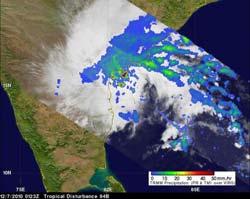NASA satellites see heavy rainfall and displaced thunderstorms in System 94B

NASA\'s TRMM satellite captured rainfall rates within System 94B near India\'s east coast on Dec. 7 at 0123 UTC. The yellow and green areas indicate moderate rainfall between .78 to 1.57 inches per hour. Red areas are heavy rainfall at almost 2 inches per hour. Credit: NASA/SSAI, Hal Pierce<br>
The Tropical Rainfall Measuring Mission (TRMM) satellite viewed an area of thunderstorms associated with System 94B near the east coast of India in the Bay of Bengal on December 7 at 0123 UTC. Data from TRMM's Precipitation Radar (PR) and Microwave Imager (TMI) showed that some severe thunderstorms in this area off the Indian coast were producing very heavy intense rainfall of over 50mm/hr (~2 inches/hour).
The TRMM satellite's main purpose is to measure rainfall over the tropics but it has also proven very valuable for monitoring development of tropical cyclones. TRMM is a joint mission between NASA and the Japanese space agency JAXA.
On Dec. 7 the center of System 94B was located about 240 nautical miles east-southeast of Chennai, India near 11.4 North latitude and 84.0 East longitude.
NASA's Aqua satellite captured an image of System 94B and continued to show that its main convection (rapidly rising air that forms the thunderstorms that power a tropical cyclone or low pressure area) are northwest of the storm's center of circulation. That's an indication that the strong wind shear that was battering the low pressure area earlier this week is still continuing.
The Atmospheric Infrared Sounder (AIRS) instrument captured an image of System 94B's cold cloud tops on Dec. 6 at 20:11 UTC (3:11 p.m. EST). The image showed most of the strongest convection, and highest, coldest cloud tops remained off-shore over the waters of the western Bay of Bengal. The coldest cloud top temperatures were as cold as or colder than -63 degrees Fahrenheit (-52 Celsius).
The AIRS infrared image did show that there were some strong thunderstorms along the immediate southeastern coast of India, where heavy rain was falling in the state of Tamil Nadu, India.
Tamil Nadu is one of the 28 states and lies in the southernmost part of the Indian Peninsula. Its capital city is Chennai located in the northeastern part of the state.
The Joint Typhoon Warning Center (JTWC) maintains forecast responsibility for this storm. The JTWC noted that maximum sustained winds at the surface are estimated between 20 to 25 knots (23 to 28 mph) and minimum sea level pressure is near 1004 millibars.
Today's JWTC forecast said, “Based on the sheared convection and relatively high vertical wind shear, the potential for the development of a significant tropical cyclone within the next 24 hours remains poor.”
So far this year five tropical cyclones have spawned in the Bay of Bengal. Tropical cyclones often form in the Bay of Bengal during the month of November but this area of low pressure isn't expected to intensify to tropical storm strength.
Media Contact
More Information:
http://www.nasa.govAll latest news from the category: Earth Sciences
Earth Sciences (also referred to as Geosciences), which deals with basic issues surrounding our planet, plays a vital role in the area of energy and raw materials supply.
Earth Sciences comprises subjects such as geology, geography, geological informatics, paleontology, mineralogy, petrography, crystallography, geophysics, geodesy, glaciology, cartography, photogrammetry, meteorology and seismology, early-warning systems, earthquake research and polar research.
Newest articles

Combatting disruptive ‘noise’ in quantum communication
In a significant milestone for quantum communication technology, an experiment has demonstrated how networks can be leveraged to combat disruptive ‘noise’ in quantum communications. The international effort led by researchers…

Stretchable quantum dot display
Intrinsically stretchable quantum dot-based light-emitting diodes achieved record-breaking performance. A team of South Korean scientists led by Professor KIM Dae-Hyeong of the Center for Nanoparticle Research within the Institute for…

Internet can achieve quantum speed with light saved as sound
Researchers at the University of Copenhagen’s Niels Bohr Institute have developed a new way to create quantum memory: A small drum can store data sent with light in its sonic…




















